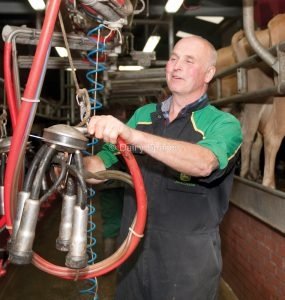
Posted 17.10.17
Keeping it simple saves on time and reduces costs
A ‘simple’ swingover parlour is keeping costs and fuss to a minimum on one Yorkshire-based unit. We paid them a visit to find out more.
Simplicity was top of the shopping list when Richard Emmott, from Penistone near Sheffield, decided he needed a new milking parlour.
His existing set-up – installed in 1985 – was, in his own words, worn out and too small. He needed something larger to milk his recently expanded pedigree Jersey herd, but he also wanted a parlour that was reliable and easy to use. “I knew that I wanted a parlour that would milk the cows with minimum fuss. A no-nonsense system,” he says.
Richard manages the 160-cow pedigree Gunthwaite herd in partnership with his wife Margeret and with full-time help from his sons Matthew and William. The cows are averaging 5,000 litres, at 6% butterfat and 4% protein, with a somatic cell count of 185,000cells/ml. The milk is sold to local dairy Longley Farms for yoghurt.
A decade ago the family milked a black and white herd, but Richard decided to switch to Jerseys because his buyer was looking for Jersey milk suppliers. “Jerseys are all about quality, rather than quantity. This higher milk consistuent meets our buyer’s requirtements and there are benefits for us too. Jerseys have great feet, legs and fertility. They’re aggresive eaters, particualry at grazing. And I’d say that they’re easier to manage, all round, compared to our previous herd.”
More stalls
The unit’s new parlour – a 20:40 Vaccar swingover set-up – was installed in a new building in 2013. This replaced a 30 year old five-a-side herringbone. “For me it was much about opting for more stalls rather than more technology. I didn’t want bells and whistles.”
That said he did opt for a few innovations, including:
- an automatic cluster flushing system, to maintain milk quality and udder health;
- an automatic plant washer, to save time while ensuring that the parlour is squeaky clean at the beginning of each and every milking;
- a dry-running vacuum pump, which requires very little maintenance and keeps the costs down.
“This pump doesn’t need regular oiling – in fact it needs no maintenance. And it’s also a lot quieter than a conventional pump,” says Richard. Dairy Spares’ Peter Larner, who helped to plan and install the new set up, adds that the pump is also fitted with a variable speed drive. “When less vacuum is required, because there are fewer clusters on cows, the pump speed slows down and that has energy savings benefits – requiring 50% less energy compared to conventional oiled vacuum pumps.
“Oiled sliding vane pumps can also achieve significant saving by using a variable speed drive – about 25% improvement compared to a conventional pump,” adds Peter.
Clean clusters
Richard particualrly likes the Clusterflush component. Once clusters are removed, water is automatically flushed through them before they are put onto the next cow. “Richard’s herd didn’t have an issue with mastitis before the new parlour was installed – seeing about 12 cases a year,” expains Peter. “But that’s halved during the passed six months – he’s seen 3 cases so far this year. Bactoscan is in single figures.”
Most importantly, the new parlour has halved milking times – from three hours per milking to just 1.5 hours. “And this is despite increasing cow numbers from 130 to 160 during the past couple of years,” says Richard. “I put this down to the simplicity of the set up and the fact that problems and glitches are minimal. We can just get on with milking and the parlour looks after itself.”
Morning milking starts at 5.30am and the afternoon session begins at 3.30pm. Richard and Matthew carry out most of the milking together, although they do have a part-time afternoon milker who comes in 5 times a week.
“Milking isn’t a chore any more. Job satisfaction has improved,” says Richard, “and because milking is quicker and the parlour doesn’t require alot of maintenance, there’s more time freed up for other day-to-day herd dairy husbandry tasks.”
Oat-husk bedding
Yields for the autumn and spring block-calved herd are monitored through the parlour. And the cows are also fed a 20% crude protein concentrate, to yield, through the system. The herds’ TMR, which comprises grass silage, fodder beet and rolled barley, provides maintenance plus 31 litres.
Tu rned out around May 1st for summer grazing and stay out until November 1st. “Although they are housed at night from the middle of September,” adds Richard.
rned out around May 1st for summer grazing and stay out until November 1st. “Although they are housed at night from the middle of September,” adds Richard.
During winter they are housed in cubicles, bedded with rubber mats and, for the past two years, oat husks. “These come fro
m the nearby Quaker Oats factory and are great for bedding cubicles – they’re really absorbent and the cows will eat some of it too. It’s also cheaper than sawdust, at between £50 and £55 per tonne compared to between £80 and £90 per tonne”.
Thanks to the new parlour, herd expansion will gradually continue to as many as 200 milkers. But Richard hasn’t set himself a ‘deadline’. Growth will be ‘organic’ using home-bred replacements. Maiden heifers are all inseminated with a sexed Jersey semen to produce heifers. And the rest of the herd is run with a beef bull. “This helps to produce a calf that’s actually worth something in the sale ring. The only drawback with Jerseys is that pure-bred bull calves are worth so little. And, like so many other aspects of dairy management on our unit, this breeding system is simple. I’d like to keep it that way.”
Tags: Vaccar




